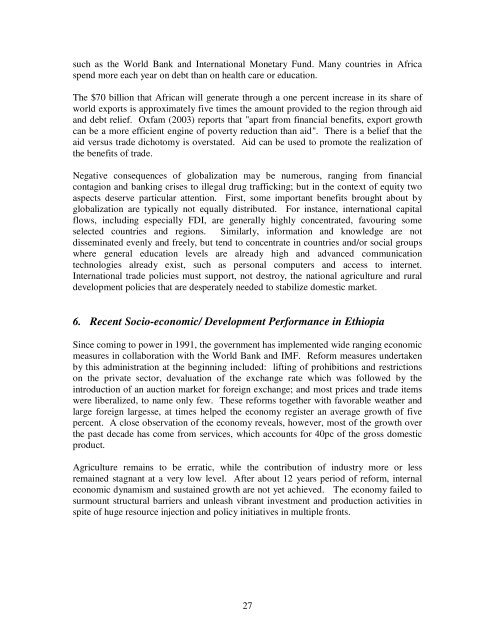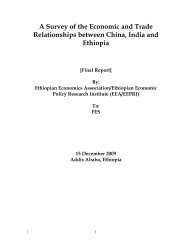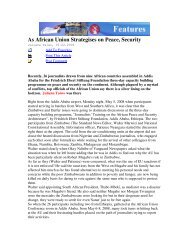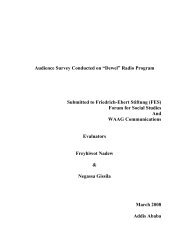external influence in the making of development ... - FES Ethiopia
external influence in the making of development ... - FES Ethiopia
external influence in the making of development ... - FES Ethiopia
You also want an ePaper? Increase the reach of your titles
YUMPU automatically turns print PDFs into web optimized ePapers that Google loves.
such as <strong>the</strong> World Bank and International Monetary Fund. Many countries <strong>in</strong> Africa<br />
spend more each year on debt than on health care or education.<br />
The $70 billion that African will generate through a one percent <strong>in</strong>crease <strong>in</strong> its share <strong>of</strong><br />
world exports is approximately five times <strong>the</strong> amount provided to <strong>the</strong> region through aid<br />
and debt relief. Oxfam (2003) reports that "apart from f<strong>in</strong>ancial benefits, export growth<br />
can be a more efficient eng<strong>in</strong>e <strong>of</strong> poverty reduction than aid". There is a belief that <strong>the</strong><br />
aid versus trade dichotomy is overstated. Aid can be used to promote <strong>the</strong> realization <strong>of</strong><br />
<strong>the</strong> benefits <strong>of</strong> trade.<br />
Negative consequences <strong>of</strong> globalization may be numerous, rang<strong>in</strong>g from f<strong>in</strong>ancial<br />
contagion and bank<strong>in</strong>g crises to illegal drug traffick<strong>in</strong>g; but <strong>in</strong> <strong>the</strong> context <strong>of</strong> equity two<br />
aspects deserve particular attention. First, some important benefits brought about by<br />
globalization are typically not equally distributed. For <strong>in</strong>stance, <strong>in</strong>ternational capital<br />
flows, <strong>in</strong>clud<strong>in</strong>g especially FDI, are generally highly concentrated, favour<strong>in</strong>g some<br />
selected countries and regions. Similarly, <strong>in</strong>formation and knowledge are not<br />
dissem<strong>in</strong>ated evenly and freely, but tend to concentrate <strong>in</strong> countries and/or social groups<br />
where general education levels are already high and advanced communication<br />
technologies already exist, such as personal computers and access to <strong>in</strong>ternet.<br />
International trade policies must support, not destroy, <strong>the</strong> national agriculture and rural<br />
<strong>development</strong> policies that are desperately needed to stabilize domestic market.<br />
6. Recent Socio-economic/ Development Performance <strong>in</strong> <strong>Ethiopia</strong><br />
S<strong>in</strong>ce com<strong>in</strong>g to power <strong>in</strong> 1991, <strong>the</strong> government has implemented wide rang<strong>in</strong>g economic<br />
measures <strong>in</strong> collaboration with <strong>the</strong> World Bank and IMF. Reform measures undertaken<br />
by this adm<strong>in</strong>istration at <strong>the</strong> beg<strong>in</strong>n<strong>in</strong>g <strong>in</strong>cluded: lift<strong>in</strong>g <strong>of</strong> prohibitions and restrictions<br />
on <strong>the</strong> private sector, devaluation <strong>of</strong> <strong>the</strong> exchange rate which was followed by <strong>the</strong><br />
<strong>in</strong>troduction <strong>of</strong> an auction market for foreign exchange; and most prices and trade items<br />
were liberalized, to name only few. These reforms toge<strong>the</strong>r with favorable wea<strong>the</strong>r and<br />
large foreign largesse, at times helped <strong>the</strong> economy register an average growth <strong>of</strong> five<br />
percent. A close observation <strong>of</strong> <strong>the</strong> economy reveals, however, most <strong>of</strong> <strong>the</strong> growth over<br />
<strong>the</strong> past decade has come from services, which accounts for 40pc <strong>of</strong> <strong>the</strong> gross domestic<br />
product.<br />
Agriculture rema<strong>in</strong>s to be erratic, while <strong>the</strong> contribution <strong>of</strong> <strong>in</strong>dustry more or less<br />
rema<strong>in</strong>ed stagnant at a very low level. After about 12 years period <strong>of</strong> reform, <strong>in</strong>ternal<br />
economic dynamism and susta<strong>in</strong>ed growth are not yet achieved. The economy failed to<br />
surmount structural barriers and unleash vibrant <strong>in</strong>vestment and production activities <strong>in</strong><br />
spite <strong>of</strong> huge resource <strong>in</strong>jection and policy <strong>in</strong>itiatives <strong>in</strong> multiple fronts.<br />
27







